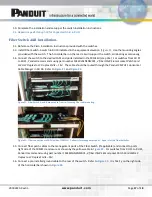
V00028CA Rev03
www.panduit.com
Page
4
of
18
IDF Switch Deployment Guide
Prior to routing power cable and horizontal communication cables, the switch placement inside the enclosure must be considered
for a successful deployment. This document is intended to provide system integrators and field installers with Panduit’s
recommendations regarding switch deployment within Panduit’s Industrial Distribution Frame (IDF). The IDF is currently
PreConfigured to support the system layout as shown in
, page 1. The allowable size of a switch in an IDF is dependent on
the following factors:
1.
RU location in the IDF.
on page 5, provides the physical useable depth of the enclosure per RU space.
2.
Switch chassis depth: Does the switch chassis fit in the physical space behind the mounting rails?
on page 6,
illustrates the dimensions:
a.
Dimension A: 25.96” [659mm] is the dimension to the back panels.
b.
Dimension B: 22.69” [576mm] is the dimension from the front rail to the horizontal copper cable D-Rings.
c.
Dimension D: 24.90” [632mm] is the dimension front the front rail to the horizontal fiber cable duct.
d.
Dimensions B and D are used for a maximum switch chassis depth.
e.
Dimensions C and E are shown for reference.
3.
Horizontal trunk cables routed inside the enclosure. The horizontal cabling D-Rings in the rear of the enclosure protrudes
from the rear wall. This is illustrated in
, Dimension B.
4.
Switch power supplies used. Some power supplies extend further past the switch chassis. An example of this is the Cisco
WS-C3850, 1100 watt power supply extends 3” past the chassis.
5.
Switch power plug locations:
a.
Are they in front of the copper cable entry?
b.
Are they in front of the fiber duct?
c.
Power cables should usually be right or left of the duct, so the useable limit may be 25.96” [659mm].
6.
Switch stack cable locations:
a.
Is there clearance to the back panels? The dimension to the back panel as 25.96” [659mm]. Note that there is
extra relief on the right side of the Top Back Panel to allow more clearance.
7.
The Center Section release handles swing into the areas where devices mount. This can result where patch cords may be
interfered with by the handles if the devices are mounted here.
The user can use some recommendations to determine if there switch will sufficiently fit inside the enclosure. The recommended
allowances for different switch characteristics are as follows:
4" - 5" [101.6 – 127mm] – add to chassis depth for stack cable
3½" [88.9mm] – add to depth for power cable support and cable loop past 3750 and 3850 power supplies
2 ½" – 3" [63.5 – 76.2mm] – add to chassis depth for power cables without strain relief brackets
Examples of planning switch deployment:
A)
A standard Cisco WS-C3850 and WS-C3850 are 17.7” to 19.2” deep. 3½” need to be added for power cable support and
cable loop resulting in 21.2” to 22.5” on the left side of the switch. If stack cables are used, add 4” – 5” to the chassis depth
resulting in 22.7” to 24.2” on the right side of the switch. These switches are useable in all RUs of the enclosure.
B)
Some switches such as the Cisco WS-C3850-48X** have a power supply option (1100W) which extends 3” from the switch
chassis. The switch chassis may be 19.2” to 20.1” deep. The physical switch depth is not a problem until power and stack
cables are taken into consideration. Adding 3” for the extended 3½” for the power cable support and loop puts
the switch at 25.5” to 26.5” deep on the left side of the switch.
a.
25.5” will fit in RUs 18 - 23, and 25 of the IDF. There is clearance behind the power supplies to the Top Back Plate.
RUs 12 – 17 are dependent on the number of horizontal trunk cables.




































